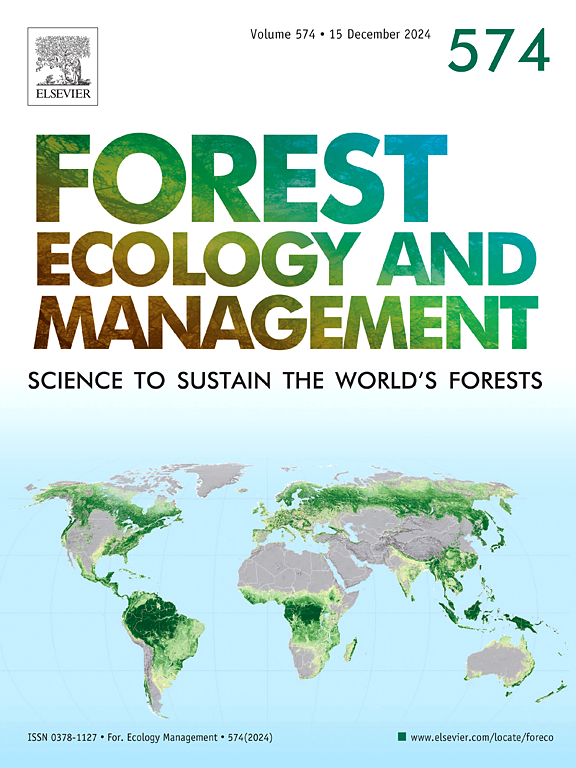Hemlock woolly adelgid infestation influences canopy structural complexity and its relationship with primary production in a temperate mixed forest
IF 3.7
2区 农林科学
Q1 FORESTRY
引用次数: 0
Abstract
Forests and the ecosystem services they provide are increasingly threatened by exotic insect pests. Among these, hemlock woolly adelgid (HWA; Adelges tsugae) causes the decline and mortality of hemlocks (Tsuga spp.) in eastern North America, threatening to extirpate hemlock throughout much of its range. Effects of HWA on forest structure vary spatially and temporally and the resulting consequences for net primary production (NPP) are poorly understood. Here, we investigated the effects of HWA on canopy structural complexity (CSC), wood NPP, and their relationship in a temperate mixed forest. We hypothesized that CSC would be greater (H1) and wood production lower (H2) in more severely disturbed plots, and that effects of CSC would mediate disturbance-production relationships (H3). We found that higher levels of HWA infestation were broadly – but not unanimously – associated with greater structural complexity across multiple canopy strata (H1), as quantified by novel unmanned aerial system (UAS)-lidar metrics. In contrast to our expectations, tree mortality during the two-year measurement window was relatively low and did not directly reduce wood production (H2). Rather, wood production was independently coupled with mid- and whole-canopy CSC (R2 = 0.96), driven in part by HWA. However, we were unable to conclude from our analysis that significant relationships between CSC and wood NPP were mediated by HWA’s effect on canopy structure (H3). Results overall suggested that HWA may generate structural complexity in the near-term through tree damage and mortality, but that the relationship between CSC and NPP may not be, or is only weakly, mediated by HWA, at least when mortality rates are low. Furthermore, the high degree of variance in wood NPP explained by CSC metrics derived from airborne lidar suggests they have potential utility for modeling and monitoring NPP in temperate forests.
温带混交林铁杉绒蚜侵染影响林冠结构复杂性及其与初级生产的关系
森林及其提供的生态系统服务日益受到外来害虫的威胁。其中,铁杉绵蚜(HWA;导致北美东部铁杉(Tsuga spp.)的衰退和死亡,威胁到铁杉在其大部分范围内的灭绝。HWA对森林结构的影响存在时空差异,其对净初级生产量的影响尚不清楚。在温带混交林中,研究了水分对林冠结构复杂性(CSC)、木材NPP的影响及其相互关系。我们假设在受干扰更严重的地块中,CSC会更大(H1),而木材产量会更低(H2),并且CSC的影响会介导干扰-生产关系(H3)。我们发现,通过新型无人机系统(UAS)-激光雷达指标进行量化,较高水平的HWA侵扰与多个树冠层(H1)的更大结构复杂性广泛(但不是一致)相关。与我们的预期相反,在两年的测量窗口期间,树木死亡率相对较低,并没有直接减少木材产量(H2)。相反,木材产量与中冠层和全冠层CSC独立耦合(R2 = 0.96),部分由HWA驱动。然而,我们无法从我们的分析中得出结论,CSC和木材NPP之间的显著关系是由HWA对冠层结构的影响介导的(H3)。结果表明,HWA可能在短期内通过树木损伤和死亡率产生结构复杂性,但CSC和NPP之间的关系可能不是或只是弱地由HWA介导,至少在死亡率较低的情况下是如此。此外,来自机载激光雷达的CSC指标解释了木材NPP的高度差异,这表明它们在温带森林的NPP建模和监测方面具有潜在的实用性。
本文章由计算机程序翻译,如有差异,请以英文原文为准。
求助全文
约1分钟内获得全文
求助全文
来源期刊

Forest Ecology and Management
农林科学-林学
CiteScore
7.50
自引率
10.80%
发文量
665
审稿时长
39 days
期刊介绍:
Forest Ecology and Management publishes scientific articles linking forest ecology with forest management, focusing on the application of biological, ecological and social knowledge to the management and conservation of plantations and natural forests. The scope of the journal includes all forest ecosystems of the world.
A peer-review process ensures the quality and international interest of the manuscripts accepted for publication. The journal encourages communication between scientists in disparate fields who share a common interest in ecology and forest management, bridging the gap between research workers and forest managers.
We encourage submission of papers that will have the strongest interest and value to the Journal''s international readership. Some key features of papers with strong interest include:
1. Clear connections between the ecology and management of forests;
2. Novel ideas or approaches to important challenges in forest ecology and management;
3. Studies that address a population of interest beyond the scale of single research sites, Three key points in the design of forest experiments, Forest Ecology and Management 255 (2008) 2022-2023);
4. Review Articles on timely, important topics. Authors are welcome to contact one of the editors to discuss the suitability of a potential review manuscript.
The Journal encourages proposals for special issues examining important areas of forest ecology and management. Potential guest editors should contact any of the Editors to begin discussions about topics, potential papers, and other details.
 求助内容:
求助内容: 应助结果提醒方式:
应助结果提醒方式:


